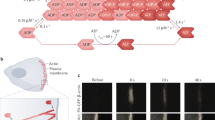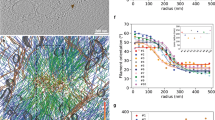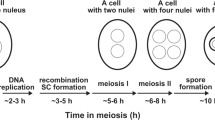Abstract
THE Gram-positive bacterium Listeria monocytogenes is a facultative intracellular pathogen capable of rapid movement through the host cell cytoplasm1. The biophysical basis of the motility of L. monocytogenes is an interesting question in its own right, the answer to which may shed light on the general processes of actin-based motility in cells. Moving intracellular bacteria display phase-dense 'comet tails' made of actin filaments, the formation of which is required for bacterial motility2,3. We have investigated the dynamics of the actin filaments in the comet tails using the technique of photoactivation of fluorescence, which allows monitoring of the movement and turnover of labelled actin filaments after activation by illumination with ultraviolet light. We find that the actin filaments remain stationary in the cytoplasm as the bacterium moves forward, and that length of the comet tails is linearly proportional to the rate of movement. Our results imply that the motile mechanism involves continuous polymerization and release of actin filaments at the bacterial surface and that the rate of filament generation is related to the rate of movement. We suggest that actin polymerization provides the driving force for bacterial propulsion.
This is a preview of subscription content, access via your institution
Access options
Subscribe to this journal
Receive 51 print issues and online access
$199.00 per year
only $3.90 per issue
Buy this article
- Purchase on Springer Link
- Instant access to full article PDF
Prices may be subject to local taxes which are calculated during checkout
Similar content being viewed by others
References
Dabiri, G. A., Sanger, J. M., Portnoy, D. A. & Southwick, F. S. Proc, natn. Acad. Sci. U.S.A. 87, 6068–6072 (1990).
Tilney, L. G. & Portnoy, D. A. J. Cell. Biol. 109, 1597–1608 (1989).
Tilney, L. G., Connelly, P. S. & Portnoy, D. A. J. Cell Biol. 111, 2979–2988 (1990).
Theriot, J. A. & Mitchison, T. J. Nature 352, 126–131 (1991).
Mitchison, T. J. J. Cell Biol. 109, 637–652 (1989)
Egelman, E. H., Francis, N. & DeRosier, D. D. Nature 298, 131–135 (1982).
Pollard, T. D. J. Cell Biol. 103, 2747–2754 (1986).
Sanger, J. M., Mittal, B., Southwick, F. S. & Sanger, J. W. J. Cell Biol. 111, 415a (1990).
Tilney, L. G., DeRosier, D. J., Weber, A. & Tilney, M. S. J. Cell Biol. (in the press).
Sanders, M. S. & Wang, Y.-L. J. Cell Biol. 110, 359–365 (1990).
Kocks, C. et al. Cell 68, 521–531 (1992).
Hill, T. L. & Kirschner, M. W. Proc. natn. Acad. Sci. U.S.A. 79, 490–494 (1982).
Oster, G. F. & Perelson, A. S. J. Cell Sci. Suppl. 8, 35–54 (1988).
Author information
Authors and Affiliations
Rights and permissions
About this article
Cite this article
Theriot, J., Mitchison, T., Tilney, L. et al. The rate of actin-based motility of intracellular Listeria monocytogenes equals the rate of actin polymerization. Nature 357, 257–260 (1992). https://doi.org/10.1038/357257a0
Received:
Accepted:
Issue Date:
DOI: https://doi.org/10.1038/357257a0
This article is cited by
-
Immunopeptidomics-based design of mRNA vaccine formulations against Listeria monocytogenes
Nature Communications (2022)
-
Actin cables and comet tails organize mitochondrial networks in mitosis
Nature (2021)
-
Synaptic vesicle traffic is supported by transient actin filaments and regulated by PKA and NO
Nature Communications (2020)
-
A dynamic beam model for the motility of Listeria monocytogenes
Acta Mechanica (2018)
-
Nucleation geometry governs ordered actin networks structures
Nature Materials (2010)
Comments
By submitting a comment you agree to abide by our Terms and Community Guidelines. If you find something abusive or that does not comply with our terms or guidelines please flag it as inappropriate.



